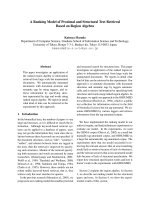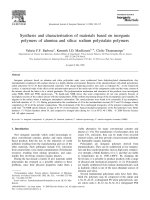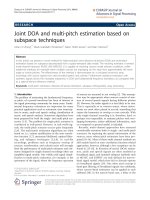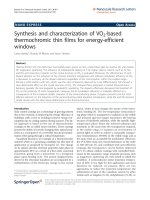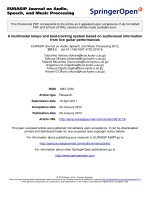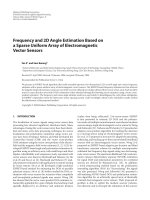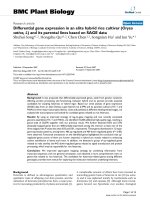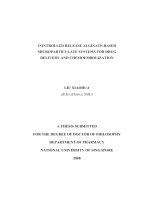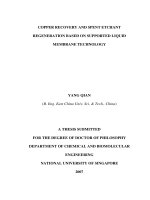Curcumin-loaded dual pH- and thermo-responsive magnetic microcarriers based on pectin maleate for drug delivery
Bạn đang xem bản rút gọn của tài liệu. Xem và tải ngay bản đầy đủ của tài liệu tại đây (2.13 MB, 8 trang )
Carbohydrate Polymers 171 (2017) 259–266
Contents lists available at ScienceDirect
Carbohydrate Polymers
journal homepage: www.elsevier.com/locate/carbpol
Curcumin-loaded dual pH- and thermo-responsive magnetic
microcarriers based on pectin maleate for drug delivery
Elizângela A.M.S. Almeida a , Ismael C. Bellettini d , Francielle P. Garcia e ,
Maroanne T. Farinácio a , Celso V. Nakamura e , Adley F. Rubira a , Alessandro F. Martins b,c,∗ ,
Edvani C. Muniz a,b
a
Grupo de Materiais Poliméricos e Compósitos (GMPC), Departamento de Qmica, Universidade Estadual de Maringá-UEM, 87020-900 Maringá-PR, Brasil
Programa de Pós-graduac¸ão em Ciência e Engenharia de Materiais (PPGCEM), Universidade Tecnológica Federal do Paraná (UTFPR), 86036-370
Londrina-PR, Brasil
c
Programa de Pós-graduac¸ão em Engenharia Ambiental (PPGEA), Universidade Tecnológica Federal do Paraná (UTFPR), 86812-460 Apucarana-PR, Brasil
d
Departamento de Qmica, Universidade Federal de Santa Catarina–UFSC, 89065-300 Blumenau-SC, Brasil
e
Laboratório de Microbiologia Aplicada aos Produtos Naturais e Sintéticos, Departamento de Ciências Básicas da Saúde, Universidade Estadual de
Maringá–UEM, 87020-900 Maringá-PR, Brasil
b
a r t i c l e
i n f o
Article history:
Received 12 February 2017
Received in revised form 10 April 2017
Accepted 9 May 2017
Available online 11 May 2017
Keywords:
Pectin
Magnetite
Poly(N-isopropyl acrylamide)
Curcumin
Release
a b s t r a c t
Magnetic microgels with pH- and thermo-responsive properties were developed from the pectin maleate,
N-isopropyl acrylamide, and Fe3 O4 nanoparticles. The hybrid materials were characterized by infrared
spectroscopy, scanning electron microscope coupled with X–ray energy dispersive spectroscopy, wide
angle X–ray scattering, Zeta potential, and magnetization hysteresis measurements. Curcumin (CUR)
was loaded into the microgels, and release assays were carried out in simulated environments (SGF
and SIF) at different conditions of temperature (25 or 37 ◦ C). A slow and sustainability CUR release was
achieved under external magnetic field influence. Loaded CUR displayed stability, bioavailability and
greater solubility regarding free CUR. Besides, the cytotoxicity assays showed that magnetic microgels
without CUR could suppress the Caco-2 cells growth. So, the pectin maleate, N-isopropyl acrylamide,
and Fe3 O4 could be tailored to elicit hybrid-based materials with satisfactory application in the medical
arena.
© 2017 Elsevier Ltd. All rights reserved.
1. Introduction
Curcumin (CUR) is widely applied in the biomedical and pharmaceutical fields owing to its anti-inflammatory capacity, and
renowned potential to treat cystic fibrosis, Alzheimer’s disease and
many cancer types (Maheshwari, Singh, Gaddipati, & Srimal, 2006).
However, the clinical application of CUR is limited because of its
low water solubility and weak oral bioavailability, as well as lack
stability under neutral and mild alkaline conditions (Tang et al.,
2010). These shortcomings should be overcome to achieve an efficient CUR approach. Microencapsulation could be used to conceive
CUR applicability, and many studies have been depicted the use of
liposomes and polymeric composites (beads, particles, and films)
∗ Corresponding author at: Programa de Pós-graduac¸ão em Ciência e Engenharia de Materiais (PPGCEM), Universidade Tecnológica Federal do Paraná (UTFPR),
86036-370 Londrina-PR, Brasil.
E-mail address: (A.F. Martins).
/>0144-8617/© 2017 Elsevier Ltd. All rights reserved.
to improve CUR efficacy (Chen et al., 2009; Li, Ahmed, Mehta, &
Kurzrock, 2007; Martins et al., 2013; Shi et al., 2007).
Polymeric materials often impart biocompatibility, biodegradability, and non-toxicity (Abolmaali, Tamaddon, & Dinarvand,
2013) to the composite materials. Regarding the drug delivery approaches, polymeric composites act as protective matrices,
repress non-specific interactions with biological molecules, foster
controlled and sustained release, and enhance the bioavailability
and stability of the loaded drug (Brewer, Coleman, & Lowman,
2011). Composite materials may increase the CUR solubility,
decreasing its crystallinity because of the establishment of new
interactions between polymer chains and CUR (Facchi et al., 2016).
Smart polymeric devices are developed focusing responsiveness
to an external magnetic field as well as changes in temperature
and pH (Patra et al., 2015). These properties are mainly required
for drug delivery purposes. Biocompatible and superparamagnetic
iron nanoparticles (SPIONs) have been highlighted due to their
renowned magnetization property. A magnetic-based material,
containing a loaded drug can adjust the release rate under external
260
E.A.M.S. Almeida et al. / Carbohydrate Polymers 171 (2017) 259–266
Table 1
Experimental conditions used to create the microparticles, loaded iron atom levels (g g−1 ) and Fe3 O4 encapsulation efficiencies (EE%).
Samples
NIPAAm wt.%
Fe3 O4 wt.%
EE(%)
Fe (10−2 g g−1 )
AP-MA/PNIPAAm(10)-Fe3 O4 (1)
AP-MA/PNIPAAm(2)-Fe3 O4 (10)
AP-MA/PNIPAAm(10)-Fe3 O4 (10)
AP-MA/PNIPAAm(2)
10
2.0
10
2.0
1.0
10
10
–
39
31
25
–
0.58
4.70
3.70
–
magnetic field influence (Patra et al., 2015). Biopolymers should
improve the SPIONs biocompatibility (Patel, Kumar, Jayawardana,
Woodworth, & Yuya, 2014) and stability (Kim, Kim, Kim, & Lee,
2009), featuring potential for target delivery (Menegucci, Santos,
Dias, Chaker, & Sousa, 2015), magnetic resonance imaging (MRI)
(Song et al., 2015) and hyperthermia purposes (Kim et al., 2009).
Overall, metallic nanoparticles (MNp) are covered by biopolymer
layers or encapsulated into a polymeric matrix. Polymer networks
stabilize the MNp by steric hindrance, suppressing the aggregation
due to the changes of pH and ionic strength (Tiwari, Mishra, Mishra,
Arotiba, & Mamba, 2011). Temperature and pH-responsiveness are
also paramount for acquisition of target delivery devices. Poly(Nisopropyl acrylamide) (PNIPAAm) is a thermo-responsive polymer
widely studied because contains a Lower Critical Solution Temperature (LCST) around 32 ◦ C, just below human body temperature.
Therefore, the PNIPAAm may be associated with polymeric systems
to yield target delivery approaches with temperature sensibility
(Jaiswal, Banerjee, Pradhan, & Bahadur, 2010).
Pectin (AP) is a polysaccharide formed by galacturonic acid
units, identified as a structural component of plant cell walls.
It is found in leaves, fruits, flowers, roots, and seeds. Pectinbased hydrogels have been used in pharmacy because of the
biocompatibility, biodegradability, non-toxicity and pH-responsive
properties (Maxwell, Belshaw, Waldron, & Morris, 2012). Also,
the AP decreases the blood cholesterol level (Brouns et al., 2012;
Terpstra, Lapre, de Vries, & Beynen, 1998), reduces the glucose
uptake (Kim, 2005), and supplies anti-tumor activity (Maxwell
et al., 2012; Zhang, Xu, & Zhang, 2015). In a natural condition, galacturonic acid units over AP-based hydrogels are ionized, permitting
repulsion among them, and hence swelling and release of drugs by
diffusion. So, these AP-systems may promote a satisfactory drug
delivery in the colon place, favoring the uptake (Liu, Fishman, Kost,
& Hicks, 2003 ; Wong, Colombo, & Sonvico, 2011).
The development of magnetic materials with pH and thermal
responses was proposed in this study. The PNIPAAm grafted on
the pectin maleate (AP–MA), and Fe3 O4 were associated to elicit
microgels using oil/water emulsion (O/W) and poly(vinyl alcohol) (PVA) as a stabilizing agent. The AP-MA synthesis, as well
as its physicochemical properties, were previously reported in a
recent paper published by our research group (Almeida et al., 2014).
Hybrid materials were loaded with curcumin (CUR), and release
tests assessed as a function of an external magnetic field at different conditions of pH and temperature. This work will demonstrate
that as-obtained microgels based on AP–MA/PNIPAAm/Fe3 O4 can
kill Caco-2 cells and to provide a suitable matrix for CUR delivery.
In this case, AP–MA/PNIPAAm/Fe3 O4 composite may improve the
solubility, stability, and bioavailability of the CUR.
2. Materials and methods
2.1. Materials
Apple pectin (Mw = 2.9 × 105 g mol−1 ), sodium persulfate (98%), iron oxide (Fe3 O4 , 98%) of particle size up to
50 nm and curcumin (Turmeric, ≥65%) were purchased
from Sigma-Aldrich (Brazil). Maleic anhydride (99%) and
N,N,N’,N’–tetramethylethylenediamine (TEMED, 99%) were sup-
plied by Vetec (Brazil). Poly(vinyl alcohol) (PVA, 88% hydrolyzed
with Mw = 2.2 × 104 g mol−1 ) and N–isopropyl acrylamide (99%)
were acquired from Across Organics (Brazil). Other reactants also
utilized in this work, were of analytical grade and used as received.
2.2. Pectin maleate/poly[N–isopropyl acrylamide]/Fe3 O4
microparticles synthesis
Firstly, the AP-MA with a substitution degree of 24% was synthesized from apple pectin (Mw = 2.9 × 105 g mol−1 ) according to
the previously procedure published by our research group (Almeida
et al., 2014). Then, for microparticles synthesis, the aqueous phase
(W) containing AP–MA (2.5 wt.%) and PVA (3.0 wt.%) was added
to the oil phase (benzyl alcohol; BnOH) containing an appropriate Fe3 O4 content (Table 1), keeping the volume ratio at 1/3
(W/BnOH). The emulsion was prepared into ice bath under N2(g)
from the sonication method (Hielscher Ultrasonic Processor, model
UP200S) at 100% amplitude for 5 min. Then, suitable quantities
of NIPAAm (2.0 or 10 wt.%, Table 1), sodium persulfate (1.5 wt.%)
and TEMED (1.0 wt.%) were added to the emulsion, maintained
the sonication for more 15 min. The suspension containing the
AP–MA/PNIPAAm–Fe3 O4 was precipitated in acetone, centrifuged,
washed five times also with acetone, stocked under vacuum (24 h)
and lyophilized (Mauricio, Guilherme, Kunita, Muniz, & Rubira,
2012). The experimental procedures are summarized in Table 1.
The microparticles will be called as AP–MA/PNIPAAm(x)–Fe3 O4 (y),
where “x” and “y” correlate the NIPAAm and Fe3 O4 levels (%),
respectively.
2.3. Characterization
Spectra of the AP-AM and AP-AM graphitized with PNIPAAm
(Supplementary Material; Fig. S1) were performed in a Varian Mercury Plus 300BB NMR spectrometer, operating at 300.06 MHz for
1 H frequency. 10 mg of the samples were dissolved in 1.0 mL D O,
2
containing TMS as reference. 1 H NMR spectra were acquired at
room temperature and the main acquisition parameters were as
follows: pulse of 90◦ , recycle delay of 30 s and acquisition of 64
transients. Measurements of Infrared Spectroscopy (FTIR) were
recorded using a Fourier Transform Infrared Spectrophotometer
(Shimadzu Scientific Instruments, Cary 630 Model), operating from
500 to 2000 cm−1 , at a resolution of 4 cm−1 after 64 scans. Scanning
Electron Microscope (SEM) coupled with X–Ray Energy Dispersive Spectroscopy (EDS) was used to evaluate the morphology and
to predict the material composition, using a Shimadzu apparatus (SS 550 model). Average diameters of the microparticles were
assessed by SEM images using the software Size Meter© , version
1.1. The LCST was evaluated by Zeta potential measurements at
different temperature conditions. Microgel suspensions were carried out in a phosphate buffer solution (pH 7.0) at 1.0 mg mL−1 and
placed in a Zetasizer Nano ZS apparatus at different temperatures
as well. The magnetization was estimated using a magnetometer (VSM), at 100 Hz frequency under 33 Oe s−1 field scan rate
(25 ◦ C). The amount of iron into the microparticles was assessed
by Flame Atomic Absorption Spectroscopy (FAAS), through a Varian
AA–175 model (USA). Wide angle X–ray scattering (WAXS) profiles
E.A.M.S. Almeida et al. / Carbohydrate Polymers 171 (2017) 259–266
261
Fig. 1. SEM images (left panel) and size distribution of the microparticles (right panel): (a, b and c) AP–MA/PNIPAAm(10)–Fe3 O4 (1), (d, e and f) AP–MA/PNIPAAm(2)–Fe3 O4 (10)
and (g, h and i) AP–MA/PNIPAAm(10)–Fe3 O4 (10).
(2 = 5–70◦ ) were obtained from a Shimadzu XRD–600 apparatus
(Japan), equipped with a Ni-filtered Cu-K␣ radiation.
2.4. Curcumin loading
Curcumin (CUR; 1.0 mg) was solubilized in ethanol (100 mL)
and, then 1.0 g AP–MA/PNIPAAm(10)–Fe3 O4 (1) was added into
the CUR-solution (Martins et al., 2013). The suspension was kept
under stirring for 20 h (25 ◦ C), avoiding light exposure. After,
the loaded microparticles were centrifuged, dried under vacuum (24 h) and lyophilized. The entrapped CUR was assessed
at = 430 nm, using an UV–vis spectrophotometer (Femto 800Xi
model) from a standard curve ranging from 0.080 to 5.0 mg L−1 ;
y = −9.9044 × 10−4 + 0.13384x (R2 = 0.999).
2.5. Curcumin release
Different environments were used to evaluate the CUR release:
simulated intestinal fluid (SIF; pH 6.8) and simulated gastric fluid
(SGF; pH 1.2) (Bueno et al., 2015). The studies were performed in an
USP type I dissolutor apparatus (Ethik Technology, 299–6TS model
− Brazil) under mechanical stirring (40 rpm) at 25 ◦ C or 37 ◦ C at the
presence or absence of the magnetic field (63.8 Oe). So, 0.10 g of
dried AP–MA/PNIPAAm(10)–Fe3 O4 (1)/CUR was deposited in cellulose membranes (12 kDa size pore), containing SGF or SIF (30 mL).
The system was stored in a sealed flask, containing 220 mL of
SGF or SIF, avoiding the light exposure. For assessing the magnetic field influence, an external magnetic field was created by a
magnet placed outside the sealed flask containing the dialysis bag.
The released CUR was determined by UV–vis absorbance ( = 430)
removing 3.0 mL aliquots at appropriate time intervals (Martins
et al., 2013). The fraction of released CUR was evaluated from Eq.
(1)
Relesead fraction =
relesead amount
× 100%
encapsulated amount
(1)
2.6. Cytotoxicity assay
Cytotoxicity tests were assessed against VERO cells (kidney cells
of African green monkey) and Caco-2 cells (human colonic adenocarcinoma cells), from the sulforhodamine B method (Almeida
et al., 2014). The cells were cultured and maintained in Dulbecco’s
®
modified Eagle’s medium (DMEM; Gibco , Grand Island, USA), supplemented with 10% heat-inactivated foetal bovine serum (FBS;
®
Gibco ) and 50 g mL−1 gentamycin, in an incubator at 37 ◦ C, with
5% CO2 and 95% relative humidity. Cells were obtained at a density
of 2.5 × 105 cells mL−1 after trypsinization and added to 96–well
plate for 24 h at the same conditions described previously. After the
adherence, a fixed volume of each microparticle suspension at different concentrations (10, 100, 500 and 1000 g mL−1 ) was added
into the 96–well plate and incubated for 48 h. The cellular toxicity
(CC50 ) is defined when the sample level kills 50% of the treated cells
regarding the control (untreated cells).
3. Results and discussion
3.1. Characterization
The methodology used to synthesize the microgels was based on
inverse polymerization technique (Mauricio et al., 2012). 1 H NMR
analysis indicated that PNIPAAm was grafted in the AP–MA chains.
The resonance signals ranging from 6.5 to 6.2 ppm on AP–MA 1 H
NMR spectrum was attributed to the hydrogen atoms in vinylic
262
E.A.M.S. Almeida et al. / Carbohydrate Polymers 171 (2017) 259–266
Fig. 2. (a) FTIR spectra of the AP–MA/PNIPAAm(2), AP-MA and AP–MA/PNIPAAm(2)–Fe3 O4 (10) (left panel). (b and c) EDS spectra and WAXS profiles, respectively: (i)
AP–MA/PNIPAAm(10)–Fe3 O4 (1), (ii) AP–MA/PNIPAAm(2)–Fe3 O4 (10), and (iii) AP–MA/PNIPAAm(10)–Fe3 O4 (10) (right panel).
Fig. 3. (a) Paramagnetic response based on the hysteresis curves. (b) Zeta potential measurements as a function of the temperature. Sample codes: (i)
AP–MA/PNIPAAm(10)–Fe3 O4 (1), (ii) AP–MA/PNIPAAm(2)–Fe3 O4 (10), and (iii) AP–MA/PNIPAAm(10)–Fe3 O4 (10).
moieties (Supporting Material, Fig. S1). These signals disappeared
in the AP–MA/PNIPAAm 1 H NMR spectrum, indicating that NIPAAm
grafting on AP–MA was successful. Such graphitization was also
confirmed due to the NIPAAm signals in the AP–MA/PNIPAAm 1 H
NMR spectrum at 3.0 and 2.7 ppm ascribed to the hydrogen atoms
on CH and CH2 , respectively (Supporting Material, Fig. S1) (Leal,
De Borggraeve, Encinas, Matsuhiro, & Muller, 2013).
The ultrasound waves ensured the obtaining of multiple and stable oil emulsion seeking to create microparticles
(Reis et al., 2011). The cavitation energy induced by the
sonication led to the formation of rough, polydisperse and
spherical microparticles with small fractures and deformities,
due to the water randomly movements into the oil phase
drops (Fig. 1) (Reis et al., 2011). The average diameters of
AP–MA/PNIPAAm(10)–Fe3 O4 (1), AP–MA/PNIPAAm(2)–Fe3 O4 (10)
and AP–MA/PNIPAAm(10)–Fe3 O4 (10) were ca. 10, 26, and 20 m,
respectively (Fig. 1). The size and polydispersity of the microgels
were raised when the magnetite level was also improved (from 1.0
up to 10 wt.%; Table 1), while the NIPAAm content did not change
these features significantly.
The
mild
band
at
600 cm−1
in
the
AP–MA/PNIPAAm(2)–Fe3 O4 (10) FTIR spectrum was assigned
to Fe–O stretching due to the Fe3 O4 load (Fig. 2a) (Mauricio et al.,
2012). The band at 1740 cm−1 on AP–MA FTIR spectrum attributed
to C O stretching of carboxylic acids was shifted for 1750 cm−1
in the AP–MA/PNIPAAm(2)–Fe3 O4 (10) spectrum, suggesting the
establishment of new interactions (Mauricio et al., 2012). Overall,
all the FTIR spectra predicted in Fig. 2a were similar between them.
The magnetite stabilized the emulsion (da Silva et al., 2014; Fang
et al., 2014) because microparticles based on AP–MA/PNIPAAm(2)
was not obtained (Supporting Material, Fig. S2). The Fe3 O4 may
neutralize the excess of negative charges over the AP–MA chain
segments by hindrance effects owing to the establishment of new
bonds among COO− and Fe (Fang et al., 2014). The EDS spectra
E.A.M.S. Almeida et al. / Carbohydrate Polymers 171 (2017) 259–266
263
Fig. 4. Fraction of released curcumin (%) from the AP–MA/PNIPAAm(10)–Fe3 O4 (1) at SIF and SGF under or not magnetic field influence: (a) at 25 and (b) at 37 ◦ C. (c) Cytotoxicity
effects against Caco-2 and VERO cells: (i) AP–MA/PNIPAAm(10)–Fe3 O4 (1), (ii) AP–MA/PNIPAAm(2)–Fe3 O4 (10) and (iii) AP–MA/PNIPAAm(10)–Fe3 O4 (10). Error bars represent
the standard deviation of triplicates (n = 3).
displayed the iron incidence in the microgels because of the peaks
at 6.4 and 7.1 keV (Fig. 2b). Even more, the WAXS profiles exhibited
characteristic diffraction peaks assigned to the Fe3 O4 crystalline
planes at 2 = 30◦ (220), 35◦ (311), 43◦ (400), 54◦ (422), 57◦ (511)
and 63◦ (440) (Fig. 2c) (Purushotham & Ramanujan, 2010). The
AP–MA/PNIPAAm(10)–Fe3 O4 (1) WAXS pattern encompassed lowered diffraction peaks regarding the other samples due to the less
level of loaded iron (0.58 × 10−2 g g−1 ; Table 1).
Fig. 3a displayed the paramagnetic behaviors of the microgels, and in Table 1 was depicted the content of iron
(g−1 ) loaded in the microparticles. The magnetization of the
AP–MA/PNIPAAm(10)–Fe3 O4 (1), AP–MA/PNIPAAm(2)–Fe3 O4 (10)
and AP–MA/PNIPAAm(10)–Fe3 O4 (10) reached 0.68 ± 0.01, 6.20
± 0.10 and 4.20 ± 0.05 emu g−1 , respectively. Polymer networks
should screen the iron atoms, suppressing the magnetic response
(Fang et al., 2014). The AP–MA/PNIPAAm(2)–Fe3 O4 (10) achieved
the highest magnetic response (6.20 ± 0.10 emu g−1 ) due to the
large Fe3 O4 content (4.7 × 10−2 g g−1 ; Table 1). TGA analysis reinforced this fact since the AP–MA/PNIPAAm(2)–Fe3 O4 (10) imparted
greater residual mass above 450 ◦ C, owing to the Fe3 O4 content
(Support Information, Fig. S3).
The thermo-sensitive feature was evaluated by Zeta potential () analysis at different temperature conditions, ranging from
25 to 50 ◦ C (Fig. 3b). For all samples, the achieved −10 to
−25 mV at pH 7.0 owing to the COO sites on AP-MA chains.
The values decreased at higher temperatures because the suspension was collapsed and conceived the LCST event (Pietsch
et al., 2012). The LCST for AP–MA/PNIPAAm(2)–Fe3 O4 (10) was
allowed at 37 ◦ C, whereas for AP–MA/PNIPAAm(10)–Fe3 O4 (10) and
AP–MA/PNIPAAm(10)–Fe3 O4 (1) was close to 43 ◦ C. The less PNIPAAm content grafted in AP–MA/PNIPAAm(2)–Fe3 O4 (10) lowered
the LCST. An LCST-type above the body temperature (≈37 ◦ C) can
allow remarkable efficiency to the composite materials to act as
drug delivery vehicles (Fang et al., 2014; Jaiswal et al., 2010).
3.2. Curcumin (CUR) release
The AP-MA/PNIPAAm(10)-Fe3 O4 (1) sample was chosen as a
drug carrier matrix due to its higher LCST (43 ◦ C) and smaller average size (≈10 m). The CUR encapsulation efficiency (EE) reached
60%. Release assays were assessed in simulated fluids (SIF or SGF)
at 25 or 37 ◦ C, under (or not) magnetic field influence. In SIF (25 ◦ C)
and without magnetic field influence, the equilibrium was reached
after 35 h when 50% CUR was released. On the other hand, in the
same condition, but under magnetic field influence, the equilibrium was permitted at 80 h, designing a slowed, modulated and
sustained CUR release (90%) (Fig. 4a). In SGF (25 ◦ C), the amount
of CUR released was not higher than 10% for all evaluated conditions (Fig. 4a). The exposition to the magnetic field may induce
heat inside the AP–MA/PNIPAAm(10)-Fe3 O4 (1), decreasing the stability and hence enhancing CUR release rate (Kumar & Mohammad,
2011; Patra et al., 2015). At 37 ◦ C, the magnetic field did not significantly change the profile of CUR release (Fig. 4b). In SIF (37 ◦ C), the
released fraction achieved 95 and 80% in the presence or absence
of magnetic field, respectively. In SGF (37 ◦ C) the content of CUR
released was lower, featuring 20% without and 6% with magnetic
field influence.
264
E.A.M.S. Almeida et al. / Carbohydrate Polymers 171 (2017) 259–266
Table 2
Kinetic parameters (n, k, ␣, and kr ) obtained by application of Ritger-Peppas and Reis et al. mathematical models on the CUR release curves evaluated in SIF.
Temperature (◦ C)
Ritger–Peppas model
Reis et al. model
R2
kr
25
25a
37
37a
a
n
k
R2
0.45
0.15
0.48
0.47
−1.17
−1.17
−0.93
−0.89
0.930
0.710
0.940
0.960
1.11
7.05
4.89
23.24
1st
2nd
1st
2nd
0.030
0.024
0.023
0.020
0.040
0.042
0.040
0.052
0.900
0.980
0.973
0.962
0.900
0.930
0.980
0.964
CUR release under magnetic field influence − 1st and 2nd refer to first- and second-order kinetics.
The amount of CUR released rose at 37 ◦ C due to the PNIPAAm.
The AP–MA/PNIPAAm(10)-Fe3 O4 (1) LCST was roughly 43 ◦ C, and
release tests were carried out at 37 ◦ C (Fig. 4b). These temperature
conditions were close, and some PNIPAAm chains could become
hydrophobic, causing polymer network collapses and enhancing
the released level of CUR, especially in SIF (37 ◦ C). These features are
also associated with hydrogel pH-responsiveness. At pH 1.2 (SGF),
all the carboxylic groups on AP–MA are entirely protonated, hindering the interactions with water molecules. This fact suppressed the
CUR release. However, at pH 6.8 (SIF) the carboxylic sites are fully
ionized ( COO− ), improving negative charge density, as predicted
by measurements. Then, the water molecules interact better with
the hybrid material, favoring the CUR delivery. Fe3 O4 nanoparticles cause tortuosity into a polymeric matrix, eliminating the burst
release of CUR (da Silva et al., 2014).
CUR comprises crystalline arrangement and has lack water solubility (≈11 ng mL−1 in a buffer solution at pH 5.0) (Martins et al.,
2013). In this study, the solubility and stability of the loaded
CUR were improved. AP-MA/PNIPAAm(10)-Fe3 O4 (1) microparticles protected the CUR integrity allowing sustained release at pH
close to physiological condition. According to the assay performed
at 25 ◦ C (SIF under magnetic field influence), the solubility of loaded
CUR reached 216 g mL−1 . Besides, the CUR was not degraded at pH
6.8 (SIF), and its bioavailability was also enhanced. These findings
open new strategies for developing of CUR-based materials with
application in the medical field.
3.3. Transport mechanism
The release of solutes from a flexible matrix may be described
by diffusion transport (Ritger & Peppas, 1987). Ritger-Peppas proposed a semi-empirical mathematical model to explain the release
mechanism of solutes (Eq. (1) (Ritger & Peppas, 1987).
Mt
= kt n
M∞
(2)
Where Mt /M∞ refers to the solute fraction released in the
desired time interval (t); k is the kinetic constant, and its value
relies on the factors such as solvent, type and shape of the hydrogel, as well as depends on the experimental conditions. In Eq. (1), n
represents the diffusion exponent being associated with the solute
transport mechanism (Brazel & Peppas, 1999; Guilherme et al.,
2010) and hydrogel geometry. For n = 1, the mechanism is governed by a zero–order kinetic and the release rate rises with the
time linearly and relies on the macromolecular relaxation. When n
is roughly 0.5, the release mechanism is controlled by Fickian diffusion; for n values ranging from 0.5 to 1.0, the anomalous transport
takes place because of the simultaneous diffusion and macromolecular relaxation. Regarding the spherical matrices, the n parameter
can assume the values: 0.43 (Fickian diffusion), 0.43–0.85 (anomalous or non-Fickian), and 0.85 (zero–order kinetic) (Ritger & Peppas,
1987).
The n and k parameters were assessed from the release curves
performed in SIF (Table 2). For n values close to 0.5, the release was
explained through non-Fickian transport (assays with fractions of
released CUR at 80, 90 and 95%; Figs. 4a–b). However, for the test
with 50% of released CUR, the lower n value (0.15) showed that
polymeric matrix/CUR set did not have affinity by the SIF (assay at
25 ◦ C in the absence of magnetic field).
At the equilibrium condition, the released fraction (Fr ) reaches a
maximum (Fmax ), and the transport mechanism can be treated as a
diffusion-partition phenomenon (Reis, Guilherme, Rubira, & Muniz,
2007). For applying this model, the Fr and Fmax parameters were
also assessed from the curves carried out in SIF, and the kinetic variables (kr ) predicted for first–order kinetic (Eq. (3) and second–order
kinetic (Eq. (4)) (Reis et al., 2007) were measured as well (Table 2).
The partition activity (␣ coefficient) is defined when the solute concentration reaches a constant value (Reis et al., 2007). For ␣ > 0,
the solute diffusion takes place between the solvent and hydrogel
phases, inferring better affinity between solute and solvent. When
␣ = 0 the solute release does not occur. There is not any solute partition between the solvent and hydrogel phases (Reis et al., 2007). All
studies showed ␣ > 0, indicating the diffusion-partition occurrence
(Table 2).
kr t = Fmax ln
Kr t =
˛
ln
2
Fmax
Fmax − Fr
Fr − 2Fr Fmax + Fmax
Fmax − Fr
(3)
(4)
The Ritger–Peppas model is valid for a time interval in which
60% solute is released (Ritger & Peppas, 1987), while the diffusionpartition model can predict the release curve profile entirely (Reis
et al., 2007). The Ritger–Peppas model was adjusted better to the
experimental outcomes performed at 37 ◦ C (R2 ≥ 0.940; Table 2 and
Fig. S4). However, the diffusion-partition model is in good accordance with the results in the interval of 60–160 h (Fig. S4 (e, f, g,
and h)) (Reis et al., 2007). The release assays at 37 ◦ C were followed
for a second-order kinetic (R2 ≥ 0.900; Table 2) and those at 25 ◦ C
were predicted by a first-order kinetic (R2 ≥ 0.964; Table 2). All conditions carried out in SIF pinpointed low and positive kr values,
explaining the sustained CUR release (Table 2).
3.4. Cytotoxicity assay
Cell viability tests against the Caco–2 colon cancer and healthy
VERO cells were evaluated from the microparticles without CUR
(Fig. 4c). The results indicated that AP–MA/PNIPAAm(10)–Fe3 O4 (1)
imparted highest cytotoxic effect on the Caco–2 cells
(65 g mL−1 CC50 ), while AP–MA/PNIPAAm(2)–Fe3 O4 (10) and
AP–MA/PNIPAAm(10)–Fe3 O4 (10) CC50 achieved 215 and
435 g mL−1 , respectively. The largest cytotoxicity found for
AP–MA/PNIPAAm(10)–Fe3 O4 (1) towards Caco–2 cells could be
attributed to the lowest loaded Fe3 O4 amount (Table 2). AP–MA
(the pristine pectin maleate) possesses greater inhibitory activity
(CC50 = 25 g mL−1 ) for Caco–2 cells as previously shown in work
published by our research group (Almeida et al., 2014). The raw
AP CC50 reached 140 g mL−1 . Fe3 O4 oxide and PNIPAAm contents
play significative role in the findings of cytotoxicity. Higher levels
E.A.M.S. Almeida et al. / Carbohydrate Polymers 171 (2017) 259–266
of Fe3 O4 and PNIPAAm could shield the AP-MA efficacy because
the AP–MA/PNIPAAm(10)–Fe3 O4 (10) CC50 was improved for
435 g mL−1 . Reports suggest the antitumor activity of AP-MA
was related to anhydride hydrolysis, and hence the formation
of hydrogen–bonded fragments (Gao et al., 2016; Pascalau et al.,
2016; Zhang et al., 2016). The Fe3 O4 /PNIPAAm excess may hinder the establishment of H–bonds among polymer networks,
decreasing the antitumor activity (Almeida et al., 2014; Karakus,
Yenidunya, Zengin, & Polat, 2011).
For healthy VERO cells, the AP–MA/PNIPAAm(10)–Fe3 O4 (10),
AP–MA/PNIPAAm(2)–Fe3 O4 (10) and AP–MA/PNIPAAm(10)–Fe3 O4 (1)
CC50 were 370, 365 and 375 g mL−1 , respectively. So, all the
microparticles were not cytotoxic towards VERO cells. It was featured that AP–MA/PNIPAAm/Fe3 O4 set could be tailored to elicit
cytocompatibility for Caco-2 cells, stability, and bioavailability
for CUR, comprising an efficient device for CUR delivery. The
cytotoxicity of the AP–MA/PNIPAAm/Fe3 O4 /CUR composites were
not assessed. Many studies, including two papers published by our
group, depicted that CUR-based composites could suppress the
growth of cancerous cells (Martins et al., 2013; Pereira et al., 2013).
4. Conclusions
A new hybrid and magnetic material based on maleate pectin
(AP–MA), PNIPAAm and Fe3 O4 was pH and thermal-responsive.
The curcumin (CUR) was loaded into the microparticles and release
findings were favored in SIF. Besides, the magnetic field influenced
the tests carried out at 25 ◦ C. Overall, the CUR release was slowly
and sustainably. The stability and bioavailability of the CUR were
also improved, and cytotoxicity assays revealed that microparticles without CUR were cytocompatible for healthy VERO cells. For
diseased Caco-2 cells, the growth was suppressed mainly under
AP–MA/PNIPAAm(10)–Fe3 O4 (1) presence (CC50 = 65 g mL−1 ). The
AP–MA/PNIPAAm/Fe3 O4 features can be useful to yield a potential
carrier device for CUR delivery.
Acknowledgements
E.A.M.S.A. thanks the CNPq for her Master fellowship. E.C M.
thanks to CNPq (Proc. 400702/2012–6 and 308337/2013–1) and
Nanobiotec (Proc. 851/09) for financial supports. The authors also
acknowledge Professors: L.C. Varanda (IQSC − USP), D.R. Cornejo
(IFSC − USP), I. A. dos Santos (DFI − UEM) and E. Radovanovic (DQI
− UEM) for their help during the developing of this work.
Appendix A. Supplementary data
Supplementary data associated with this article can be found, in
the online version, at />034.
References
Abolmaali, S. S., Tamaddon, A. M., & Dinarvand, R. (2013). A review of therapeutic
challenges and achievements of methotrexate delivery systems for treatment
of cancer and rheumatoid arthritis. Cancer Chemotherapy and Pharmacology,
71(5), 1115–1130.
Almeida, E. A. M. S., Facchi, S. P., Martins, A. F., Nocchi, S., Schuquel, I. T. A.,
Nakamura, C. V., & Muniz, E. C. (2014). Synthesis and characterization of pectin
derivative with antitumor property against Caco-2 colon cancer cells.
Carbohydrate Polymers, 115, 139–145.
Brazel, C. S., & Peppas, N. A. (1999). Mechanisms of solute and drug transport in
relaxing, swellable, hydrophilic glassy polymers. Polymer, 40(12), 3383–3398.
Brewer, E., Coleman, J., & Lowman, A. (2011). Emerging technologies of polymeric
nanoparticles in cancer drug delivery. Journal of Nanomaterials, 2011, 1–10.
Brouns, F., Theuwissen, E., Adam, A., Bell, M., Berger, A., & Mensink, R. P. (2012).
Cholesterol-lowering properties of different pectin types in mildly
hyper-cholesterolemic men and women. European Journal of Clinical Nutrition,
66(5), 591–599.
265
Bueno, P. V. A., Souza, P. R., Follmann, H. D. M., Pereira, A. G. B., Martins, A. F.,
Rubira, A. F., & Muniz, E. C. (2015). N, N-Dimethyl chitosan/heparin
polyelectrolyte complex vehicle for efficient heparin delivery. International
Journal of Biological Macromolecules, 75, 186–191.
Chen, C., Johnston, T. D., Jeon, H., Gedaly, R., McHugh, P. R., Burke, T. G., & Ranjan, D.
(2009). An in vitro study of liposomal curcumin: Stability, toxicity and
biological activity in human lymphocytes and Epstein-Barr virus-transformed
human B-cells. International Journal of Pharmaceutics, 366(1-2), 133–139.
da Silva, E. P., Sitta, D. L. A., Fragal, V. H., Cellet, T. S. P., Mauricio, M. R., Garcia, F. P.,
& Kunita, M. H. (2014). Covalent TiO2/pectin microspheres with Fe3O4
nanoparticles for magnetic field-modulated drug delivery. International Journal
of Biological Macromolecules, 67, 43–52.
Facchi, S. P., Scariot, D. B., Bueno, P. V. A., Souza, P. R., Figueiredo, L. C., Follmann, H.
D. M., & Martins, A. F. (2016). Preparation and cytotoxicity of N-modified
chitosan nanoparticles applied in curcumin delivery. International Journal of
Biological Macromolecules, 87, 237–245.
Fang, J. H., Lai, Y. H., Chiu, T. L., Chen, Y. Y., Hu, S. H., & Chen, S. Y. (2014). Magnetic
Core?Shell nanocapsules with Dual-Targeting capabilities and Co-Delivery of
multiple drugs to treat brain gliomas. Advanced Healthcare Materials, 3(8),
1250–1260.
Gao, N. N., Lu, S. Y., Gao, C. M., Wang, X. G., Xu, X. B., Bai, X., & Liu, M. Z. (2016).
Injectable shell-crosslinked F127 micelle/hydrogel composites with pH and
redox sensitivity for combined release of anticancer drugs. Chemical
Engineering Journal, 287, 20–29.
Guilherme, M. R., Reis, A. V., Paulino, A. T., Moia, T. A., Mattoso, L. H. C., &
Tambourgi, E. B. (2010). Pectin-Based polymer hydrogel as a carrier for release
of agricultural nutrients and removal of heavy metals from wastewater. Journal
of Applied Polymer Science, 117(6), 3146–3154.
Jaiswal, M. K., Banerjee, R., Pradhan, P., & Bahadur, D. (2010). Thermal behavior of
magnetically modalized poly(N-isopropylacrylamide)-chitosan based
nanohydrogel. Colloids and Surfaces B-Biointerfaces, 81(1), 185–194.
Karakus, G., Yenidunya, A. F., Zengin, H. B., & Polat, Z. A. (2011). Modification of
maleic anhydride-Styrene copolymer with noradrenaline by chemical and
enzymatic methods. Journal of Applied Polymer Science, 122(4), 2821–2828.
Kim, D. H., Kim, K. N., Kim, K. M., & Lee, Y. K. (2009). Targeting to carcinoma cells
with chitosan- and starch-coated magnetic nanoparticles for magnetic
hyperthermia. Journal of Biomedical Materials Research Part A, 88A(1), 1–11.
Kim, M. (2005). High-methoxyl pectin has greater enhancing effect on glucose
uptake in intestinal perfused rats. Nutrition, 21(3), 372–377.
Kumar, C. S. S. R., & Mohammad, F. (2011). Magnetic nanomaterials for
hyperthermia-based therapy and controlled drug delivery. Advanced Drug
Delivery Reviews, 63(9), 789–808.
Leal, D., De Borggraeve, W., Encinas, M. V., Matsuhiro, B., & Muller, R. (2013).
Preparation and characterization of hydrogels based on homopolymeric
fractions of sodium alginate and PNIPAAm. Carbohydrate Polymers, 92(1),
157–166.
Li, L., Ahmed, B., Mehta, K., & Kurzrock, R. (2007). Liposomal curcumin with and
without oxaliplatin: effects on cell growth, apoptosis, and angiogenesis in
colorectal cancer. Molecular Cancer Therapeutics, 6(4), 1276–1282.
Liu, L. S., Fishman, M. L., Kost, J., & Hicks, K. B. (2003). Pectin-based systems for
colon-specific drug delivery via oral route. Biomaterials, 24(19), 3333–3343.
Maheshwari, R. K., Singh, A. K., Gaddipati, J., & Srimal, R. C. (2006). Multiple
biological activities of curcumin: A short review. Life Sciences, 78(18),
2081–2087.
Martins, A. F., Bueno, P. V. A., Almeida, E. A. M. S., Rodrigues, F. H. A., Rubira, A. F., &
Muniz, E. C. (2013). Characterization of N-trimethyl chitosan/alginate
complexes and curcumin release. International Journal of Biological
Macromolecules, 57, 174–184.
Mauricio, M. R., Guilherme, M. R., Kunita, M. H., Muniz, E. C., & Rubira, A. F. (2012).
Designing nanostructured microspheres with well-defined outlines by mixing
carboxyl-functionalized amylose and magnetite via ultrasound. Chemical
Engineering Journal, 189, 456–463.
Maxwell, E. G., Belshaw, N. J., Waldron, K. W., & Morris, V. J. (2012). Pectin − An
emerging new bioactive food polysaccharide. Trends in Food Science &
Technology, 24(2), 64–73.
Menegucci, J. D., Santos, M., Dias, D. J. S., Chaker, J. A., & Sousa, M. H. (2015).
One-step synthesis of magnetic chitosan for controlled release of
5-hydroxytryptophan. Journal of Magnetism and Magnetic Materials, 380,
117–124.
Pascalau, V., Soritau, O., Popa, F., Pavel, C., Coman, V., Perhaita, I., & Popa, C. (2016).
Curcumin delivered through bovine serum albumin/polysaccharides
multilayered microcapsules. Journal of Biomaterials Applications, 30(6),
857–872.
Patel, N. G., Kumar, A., Jayawardana, V. N., Woodworth, C. D., & Yuya, P. A. (2014).
Fabrication, nanomechanical characterization, and cytocompatibility of
gold-reinforced chitosan bio-nanocomposites. Materials Science & Engineering
C-Materials for Biological Applications, 44, 336–344.
Patra, S., Roy, E., Karfa, P., Kumar, S., Madhuri, R., & Sharma, P. K. (2015).
Dual-Responsive polymer coated superparamagnetic nanoparticle for targeted
drug delivery and hyperthermia treatment. ACS Applied Materials & Interfaces,
7(17), 9235–9246.
Pereira, A. G. B., Fajardo, A. R., Nocchi, S., Nakamura, C. V., Rubira, A. F., & Muniz, E.
C. (2013). Starch-based microspheres for sustained-release of curcumin:
preparation and cytotoxic effect on tumor cells. Carbohydrate Polymers, 98(1),
711–720.
266
E.A.M.S. Almeida et al. / Carbohydrate Polymers 171 (2017) 259–266
Pietsch, C., Mansfeld, U., Guerrero-Sanchez, C., Hoeppener, S., Vollrath, A., Wagner,
M., & Schubert, U. S. (2012). Thermo-Induced self-Assembly of responsive
poly(DMAEMA-b-DEGMA)Block copolymers into multi- and unilamellar
vesicles. Macromolecules, 45(23), 9292–9302.
Purushotham, S., & Ramanujan, R. V. (2010). Thermoresponsive magnetic
composite nanomaterials for multimodal cancer therapy. Acta Biomaterialia,
6(2), 502–510.
Reis, A. V., Guilherme, M. R., Rubira, A. F., & Muniz, E. C. (2007). Mathematical
model for the prediction of the overall profile of in vitro solute release from
polymer networks. Journal of Colloid and Interface Science, 310(1), 128–135.
Reis, A. V., Guilherme, M. R., de Almeida, E. A. M. S., Kunita, M. H., Muniz, E. C.,
Rubira, A. F., & Tambourgi, E. B. (2011). Copolymer hydrogel microspheres
consisting of modified sulfate chondroitin-co-Poly(N-isopropylacrylamide).
Journal of Applied Polymer Science, 121(5), 2726–2733.
Ritger, P. L., & Peppas, N. A. (1987). A simple equation for description of solute
release II. Fickian and anomalous release from swellable devices. Journal of
Controlled Release, 5(1), 37–42.
Shi, W., Dolai, S., Rizk, S., Hussain, A., Tariq, H., Averick, S., & Raja, K. (2007).
Synthesis of monofunctional curcumin derivatives, clicked curcumin dimer,
and a PAMAM dendrimer curcumin conjugate for therapeutic applications.
Organic Letters, 9(26), 5461–5464.
Song, X., Luo, X., Zhang, Q., Zhu, A., Ji, L., & Yan, C. (2015). Preparation and
characterization of biofunctionalized chitosan/Fe3O4 magnetic nanoparticles
for application in liver magnetic resonance imaging. Journal of Magnetism and
Magnetic Materials, 388, 116–122.
Tang, H., Murphy, C. J., Zhang, B., Shen, Y., Van Kirk, E. A., Murdoch, W. J., & Radosz,
M. (2010). Curcumin polymers as anticancer conjugates. Biomaterials, 31(27),
7139–7149.
Terpstra, A. H. M., Lapre, J. A., de Vries, H. T., & Beynen, A. C. (1998). Dietary pectin
with high viscosity lowers plasma and liver cholesterol concentration and
plasma cholesteryl ester transfer protein activity in hamsters. Journal of
Nutrition, 128(11), 1944–1949.
Tiwari, A. D., Mishra, A. K., Mishra, S. B., Arotiba, O. A., & Mamba, B. B. (2011). Green
synthesis and stabilization of gold nanoparticles in chemically modified
chitosan matrices. International Journal of Biological Macromolecules, 48(4),
682–687.
Wong, T. W., Colombo, G., & Sonvico, F. (2011). Pectin matrix as oral drug delivery
vehicle for colon cancer treatment. Aaps Pharmscitech, 12(1), 201–214.
Zhang, W. B., Xu, P., & Zhang, H. (2015). Pectin in cancer therapy: A review. Trends
in Food Science & Technology, 44(2), 258–271.
Zhang, Y. M., Yang, C. H., Wang, W. W., Liu, J. J., Liu, Q., Huang, F., . . . & Lui, J. F.
(2016). Co-delivery of doxorubicin and curcumin by pH-sensitive prodrug
nanoparticle for combination therapy of cancer. Scientific Reports, 6
